|
 Secure Site
Secure Site
|
 |
Archive for the 'Well-being' Category
 morning meditation practice with meditation timer Sense the Stillness
You don’t have to be a regular yoga or meditation practitioner to reap the benefits of a morning meditation ritual. Start with five minutes daily, using the guidelines that follow. Then over the course of a few weeks — or when you are ready — gradually work up to 10 minutes. Remember, with meditation it’s quality, not quantity, that matters.
Start with awareness. Rather than lunge out of bed, Novie suggests waking up slowly. “Spend a few minutes just becoming conscious of the sensations of your body. Awareness is such a beautiful way of entering your day.” Once you’re up, resist the temptation to check your e-mail, flip on the radio, or do any of the other countless things that draw you out of yourself and into the concerns of the world. Instead, keep the focus inward.
Find a comfortable spot. Practice your five minutes of meditation anywhere you like (the bedroom floor, a favorite chair) except the bed, where you may fall back to sleep. Be sure to set your Singing Bowl Meditation Timer (Now & Zen, $199.95) for 5 minutes so that your session can end with a calm chime. To enhance the sacred aspect of her meditation space, Novie set up a small altar in her living room that she uses only for meditation, giving the space a positive energy of its own.
Sense your breath. Close your eyes. Feel your breath moving in and out of your body without controlling it. Bring your attention to the rise and fall of your abdomen or to the tip of your nose. The more awareness you bring to breath and body, the more grounded in your body you’ll become. This, in turn, will help relieve some of the stress that comes with getting through your morning.
Don’t try to block your thoughts. Your mind will wander — that’s what it’s designed to do. Rather than try to fight off thoughts as they emerge, acknowledge them, but don’t engage them. And give yourself some slack — meditation is, after all, a practice, not perfection.
For yoga instructor Alison Novie, mornings make an ideal time for meditation — perhaps more than any other time of day. “The sun’s about to rise, but it’s still sort of dark and quiet,” says Novie, who wakes at 5:00 a.m. to meditate. “I get up, brush my teeth, light a candle, and then sit for half an hour. The calm energy I get from that morning meditation carries me through the day.”
adapted from Body + Soul Magazine, March 2006
Our Singing Bowl Meditation Timer called The Zen Timepiece is an acoustic 6-inch brass bowl-gong clock. It is the world’s ultimate alarm clock, practice timer, and “mindfulness bell.”
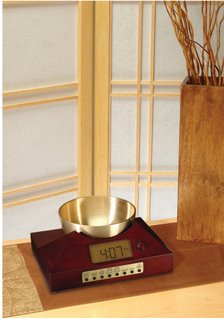 Singing Bowl Meditation Timer is Ideal for Morning Meditation Practice
Now & Zen’s Singing Bowl Meditation Timer Shop
1638 Pearl Street
Boulder, CO 80302
(800) 779-6383
Posted in Chime Alarm Clocks, Meditation Timers, Meditation Tools, mindfulness practice, Well-being, Zen Timers
 Meditation Practice, Stillness of Being For a formal practice to cultivate equanimity, begin with some calming breaths or a mantra meditation. Once you feel calm, reflect on your desire for happiness and freedom from suffering, both for yourself and for others. Contemplate your desire to serve the needs of others and to be compassionately engaged in the world. Acknowledge both the joy and the suffering that exist throughout the world—the good deeds and the evil ones. As you continue to breathe into your heart’s center, acknowledge the necessity of balancing your desire to make positive change in the world with the reality that you cannot control the actions of others.
Bring to mind the image of someone for whom you have no strong feelings one way or the other. With this person in your mind’s eye, repeat the following phrases to yourself, coordinating with the outbreath if you like:
- All beings like yourself are responsible for their own actions.
- Suffering or happiness is created through one’s relationship to experience, not by experience itself.
- Although I wish only the best for you, I know that your happiness or unhappiness depends on your actions, not on my wishes for you.
- May you not be caught in reactivity.
Feel free to use other similar, appropriate phrases of your own devising. After a few minutes, shift your attention to your benefactors, including teachers, friends, family and the unseen workers who keep the societal infrastructure working. Silently repeat the phrases to yourself as you contemplate these benefactors.
After several minutes, begin to reflect on your loved ones, directing the phrases to them, followed by the difficult people in your life. While feeling kindness, compassion, and joy for those we love comes more easily than it does for those with whom we have difficulty, it is often the opposite with equanimity. It’s a lot easier to accept that those we dislike are responsible for their own happiness than it is for those we care for deeply, because we feel more attachment to them. Whatever your experience, simply note any reactivity and see if you can be equanimous with your reactivity! Broaden your reach after a few minutes to include all beings everywhere throughout the world, and then finally contemplate equanimity in regard to yourself, noticing how taking responsibility for your own happiness and unhappiness can feel the hardest of all.
- All beings, including myself, are responsible for their own actions.
- Suffering or happiness is created through one’s relationship to experience, not by experience itself.
- Although I wish only the best for myself, I know that my happiness or unhappiness depends on my actions, not my wishes for myself.
- May I not be caught in reactivity.
adapted from Yoga Journal by Frank Boccio
Frank Jude Boccio is a teacher of yoga and Zen Buddhism and the author of Mindfulness Yoga. Find him at mindfulnessyoga.net.
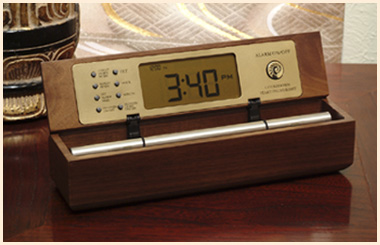 Meditation Timer for Your Meditation Practice The Walnut Digital Zen Clock’s long-resonating Tibetan bell-like chime makes waking up and meditating a beautiful experience – its progressive chimes begin your day with grace. When the clock’s alarm is triggered, the acoustic chime bar is struck just once … 3-1/2 minutes later it strikes again … chime strikes become more frequent over 10 minutes … eventually striking every 5 seconds until shut off. As they become more frequent, the gentle chimes will always wake you up or bring you out of your meditation. Your body really doesn’t need to be awakened harshly, with a Zen Clock you’re awakened more gradually and thus more naturally. Unlike artificial recorded sounds coming out of a tiny speaker in a plastic box, natural acoustic sounds transform your bedroom or office environment.
The Digital Zen Clock also serves as a countdown and interval timer for yoga, meditation, bodywork, etc.; and it can also be set to chime on the hour as a tool for “mindfulness.”
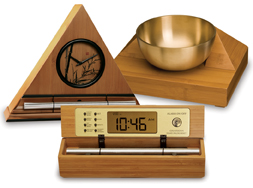 Find the Entire Family of Meditation Timer and Gongs at Now & Zen's Store in Boulder Now & Zen’s Meditation Timer Store
1638 Pearl Street
Boulder, CO 80302
(800) 779-6383
Posted in intention, Meditation Timers, Meditation Tools, mindfulness practice, Well-being, Zen Timers
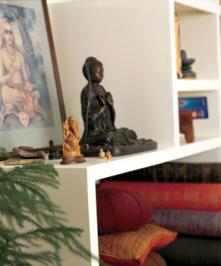 creating a meditation space in your home • It doesn’t really matter where your meditation space is located in your house, although Rodney Yee says the Balinese consider the northeast corner culturally and religiously auspicious. Tias Little likes the southeast corner because it captures morning light for early meditation. Basically, says Yee, pick a space where you feel relaxed and comfortable. “I think everybody has a special little place where they go to be quiet—just like a cat that searches until it finds the right spot to sleep.”
• You can think big thoughts in any size space. Your meditation area can be as expansive as Richard Freeman’s, a room “at the very top of the house, encompassed by a big maple tree,” or simply a spare closet or an empty corner. Rainbeau Mars likes a window for fresh air as long as it’s not distracting, but Little says a semi-enclosed space can give a “really spectacular feeling, like a little womb.” You might consider creating a six- or seven-foot-square adobe “cell” addition to your house or yard.
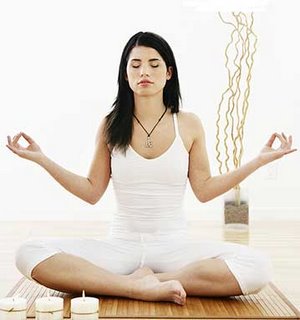 meditation space • “Anyone can use [a meditation space], but only for meditation,” Deepak Chopra says. Freeman says to minimize distraction, you should choose a location that’s as isolated as possible from the traffic flow in your house, and it shouldn’t be in an area where you’re more tempted to sleep than meditate. If you share your space, each person should have his or her own chair, cushion, zabuton mat, or zafu pillow, “something that sanctifies this is my space,” Mars says. Sit on it only when you meditate. That helps create a ritual conducive to meditation, Judith Hanson Lasater says. It is nice to have a special Zen Meditation Timer on a table beside your the chair or cushion that you meditate on. This way you can easily reach the meditation timer to turn it off when it chimes and then you can continue to sit in peace until ready to move.
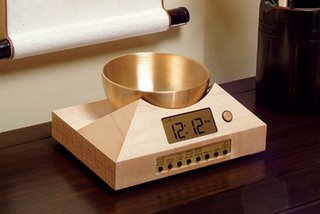 Zen Timepiece, a brass singing bowl clock and timer • Tatami mats or bare wood floors are a better, cleaner option than rugs or carpets, and they create a more spacious feeling, Little says.
• An altar is a good idea. “When you set it up, the space begins to get that special feeling,” Yee says. An altar makes it clear the space is reserved for meditation and serves as a repository for your sacred objects and decorations. It needn’t be elaborate: Little has seen window sills used as altars. Yee’s altar is a small, low table covered with a Balinese cloth; Freeman’s is a stone slab.
• If you do yoga in your meditation space, store props such as mats, blocks, and straps in a chest. Leaving them out creates distracting clutter.
• Avoid bright overhead lighting, or use a dimmer switch. Lamps or sconces are best because they combine illumination with warmth.
• Include a timer. Meditation is all about discipline and consistency, and meditating a set amount of time each day can help achieve that, Lasater says. The Zen Timepiece chimes gently at the end of one’s meditation without startling one back to the here and now.
 Bamboo Zen Meditation Timer • Even experts disagree on how to decorate your space. Most are minimalists. “It needs to be elegant in its simplicity and with very little clutter,” Chopra says. His recommended decorations include candles, books, and symbolic representations of archetypal figures such as gods, goddesses, angels, flowers, incense, and pastel colors. “You should not include anything that symbolically represents violence,” he adds. Yet not everyone finds minimalism calming, points out Freeman. “Some people display every saint they’ve ever heard of; some people may have only one. Others might light a candle; others prefer nothing. It’s whatever makes you want to sit there and do nothing.”
adapted from Natural Home Magazine, Jan/Feb 2005 by Vicky Uhland
Posted in Bamboo Chime Clocks, Japanese Inspired Zen Clocks, Meditation Timers, Meditation Tools, mindfulness practice, Well-being, Zen Timers
 Try a Listen Meditation as a Mindfulness Practice Listening Meditation
Instructor Sally Kempton is a spiritual guide who teaches yoga and meditation at her Carmel, Calif.-based Awakened Heart Meditation (sallykempton.com). She authored The Heart of Meditation under her monastic name Swami Durgananda.
What is it? While many meditation techniques require solitude and silence, this one has you engage with the sounds all around you; it invites you to work with and use the noise instead of fighting it. Listening meditation also encourages you to harmonize with your surroundings, and, by extension, the universe. The intent is to experience sound as vibration, rather than information. The listening practice is a way of interacting with the environment that allows you to take in the whole energy of the present moment, says Kempton.
What’s it good for? Especially adaptable and portable, listening meditation can be practiced in crowded, noisy situationson a bus, at the office that would be hard on other styles. (Kempton once led a listening meditation workshop in the middle of a busy Whole Foods store!) People with particularly chattering minds may need to couple this practice with a mantra or breathing meditation. However, many people welcome the chance to focus outward rather than inward and find that listening meditation is one of the easier techniques to undertake. You’ll come away from it feeling refreshed, expanded, and at ease with your environment, declares Kempton.
How long does it take? Try for five minutes at first, then add a minute or two until you can do it for 15 or 20 minutes at a time. Set your Chime Meditation Timer by Now & Zen for five minutes and then increase as you get better at this practice.
How Do I Do It?
1. Set your Meditation Chime Timer for 5 minutes (increase the minutes as you improve). Sit in a comfortable position and close (or half close) your eyes.
2. To get centered and quiet the mind, first bring your awareness to your breath, noticing but not trying to change it.
3. Now open your ears and bring your awareness to the sounds around you. The goal is to listen to the whole range of sounds, without favoring one over another and without identifying them. Hear the quiet sounds and the silences as well as the dominant sounds.
4. When you find yourself identifying sounds (there’s a fire engine; thats the cat scratching the rug), gently redirect your attention from listening to a specific noise back to hearing the whole spectrum of sounds.
5. To end, slowly open your eyes, stand, and carry this heightened awareness with you for as long as you can.
Tip: Do a one-minute mini-listening meditation while standing in line or sitting at your desk, or anytime you feel frazzled: Close your eyes, breathe, and listen to the sounds around you. Like the practice of counting to 10 when you’re in the heat of an argument, this will help you pause, center, and regroup.
 Zen Meditation Timers, The Digital Zen Alarm Clock in Solid Walnut adapted from Natural Health Magazine
Now & Zen’s Chime Time Store
1638 Pearl Street
Boulder, CO 80302
(800) 779-6383
Posted in Bamboo Chime Clocks, Chime Alarm Clocks, intention, Meditation Timers, Meditation Tools, mindfulness practice, Well-being, Zen Timers
 Awaken gradually Dreaming of a Good Night’s Rest
How you awaken each morning can also influence how well you sleep. Some experts believe your body is naturally designed to awaken gradually with the rising sun and should not to be jarred awake by a screaming alarm clock. Dawn simulators recreate a natural sunrise by slowly increasing the intensity of light in the room. A study in BMC Psychiatry found that dawn simulators improved the quality of sleep during winter months for a group of about 80 randomly chosen people.
The right light can also help you fall asleep more easily. Studies have shown that exposure to 2,000- to 10,000-lux light (the equivalent of gazing at the horizon on a sunny day and up to 20 times brighter than normal room lighting) can improve overall sleep quality, says psychiatrist Daniel Kripke, MD, of the University of California, San Diego. This is most beneficial for about 20 to 30 minutes in the morning and a few hours prior to bed. More specifically, light therapy has been used to reset body clocks for those with sleep-timing problems and to correct erratic sleep habits caused by depression. A recent study in the journal Sleep found that evening exposure from a light box effectively treated people who often woke up too early and were unable to fall back to sleep. Exactly how light therapy improves sleep for people with depression remains unknown, Kripke says, but one popular theory is that bright light increases sleep-aiding serotonin levels.
Now & Zen’s Digital Zen Clock’s long-resonating Tibetan bell-like chime makes waking up a beautiful experience – its progressive chimes begin your day with grace. When the clock’s alarm is triggered, the acoustic chime bar is struck just once … 3-1/2 minutes later it strikes again … chime strikes become more frequent over 10 minutes … eventually striking every 5 seconds until shut off. As they become more frequent, the gentle chimes will always wake you up – your body really doesn’t need to be awakened harshly, with a Zen Clock you’re awakened more gradually and thus more naturally. Unlike artificial recorded sounds coming out of a tiny speaker in a plastic box, natural acoustic sounds transform your bedroom or office environment.
adapted from Natural Solutions Magazine, December 2005 by Matthew Sloan
 Natural Awakening, Digital Zen Alarm Clock Now & Zen’s Chime Alarm Clock Shop
1638 Pearl Street
Boulder, CO 80302
(800) 779-6383
Posted in Chime Alarm Clocks, Japanese Inspired Zen Clocks, Natural Awakening, Now & Zen Alarm Clocks, Progressive Awakening, sleep, Sleep Habits, wake up alarm clock, Well-being
 Soaking Water, a powerful and restorative element in exquisite rituals throughout the ages, finds itself front and center in most spiritual rites of passage. Many cultures consider water essential for both physical and spiritual cleansing, and millions continue to embark upon quests to holy rivers and healing springs, drawn to water equally for its soothing properties as well as its promise of purification.
Perhaps this draw to water feels so instinctual because our brains, blood, and even our muscles are composed mainly of water. When we submerge ourselves, we return, in essence, to a deep, primordial connection with the world around us. Through the simple act of bathing, we can celebrate this ancient relationship between water and life. With minimal effort, a daily bath becomes a meditative and mystical experience, helping us to connect with our own inner wisdom.
“Mankind has used water to restore the physical, mental, and emotional body since ancient times,” says Barbara Close, founder of Naturopathica Holistic Health and author of Pure Skin: Organic Beauty Basics (Chronicle Books, 2005). “From the beginning, the use of water as a conduit or healing agent has existed for both its physical and emotional healing properties.”
Long before holy wells began to draw pilgrims or the custom of “taking the waters” became popular at lavish bathing halls in Europe, ancient cultures in Asia, Indonesia, and Mesoamerica had their own elaborate bathing rituals, which often involved the use of steam and ceremonial sound. Both the Aztec Temazcal and Mayan Zumbul-che wove in musical elements to signify the start of the cleansing ritual. In parts of today’s world, including Indonesia, Southeast Asia, and island nations of the Pacific, cultures still associate wells, springs, and rivers with the Goddess, the feminine principle, and birth. Women add flower petals to ritual water as an extra flourish, imbuing their bath with the powerful spiritual energy associated with native plants. In the Javanese bath ritual that prepares brides for their wedding night, attendants first scrub and exfoliate the skin with turmeric and then rub it with yogurt to soften it. A luxurious bath with flowers and petals follows, and only then is the bride deemed purity incarnate.
 soaking in sacred water “Each and every one of us, and every fragment of life on our planet, has an inner and outer relationship with water,” says Nadine Epstein, author (with Rosita Arvigo) of Spiritual Bathing: Healing Rituals and Traditions From Around the World (Celestial Arts, 2003). “The first living cells were formed in the salt bath of the sea, and I love imagining the blood that flows within us as a kind of internal sea. We are beings of water on a planet that is distinguished by its possession of water, the rushing waters that the early Jews called ‘living waters’ or mayyim hayyim.”
Ritual and renewal
You can connect with the healing energy of water by preparing your own spiritual bath at home. First order of business: Decide what you want to manifest in your life. The prospects run the gamut from the desire to release personal sadness or frustration to the hope of reducing global suffering. Next, establish the mood. The usual suspects, candles and incense, have traditionally been part of many prayer settings, but let your imagination run wild. Create an even richer ambiance by including specific music, scents, symbols, and images that resonate with your concept of the divine.
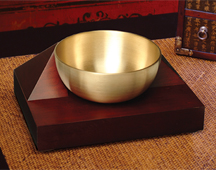 Set Your Singing Bowl Chime Timer for a Sacred Soak at Home “Personally, I love singing and chanting on the surface of the water, watching the ripples of my breath, and soaking up the sounds in the air,” says Epstein. “I’ve always been fascinated by sound waves and how they travel through solids, gases, and liquids. As a little girl, I remember my father, a physicist, mapping the trajectory of sound waves through crystals. The symmetries of these waves were and are a beautiful thing to behold. It all boils down to connecting with what the Maya call ch’ulel, the Chinese call chi, the Hindus call prana. Nearly every culture has a name for the subtle energies or vibrations that exist within us and beyond.”
Ultimately, only the reverence with which we enter the water matters. If we are receptive enough, our immersions can gradually wring a sea change upon our spirit, teaching us that we can learn as much from floating as we can from standing on firm ground.
Liquid Assets
By varying water temperature, length of soaking time, and what you add to the bath, you can create a variety of healing environments.
“Adding herbal extracts and essential oils can intensify the healing experience,” explains Barbara Close, herbalist, aromatherapist, and founder of Naturopathica. “Essential oils are lipophyllic—meaning that they repel water and are attracted to fat-based substances such as the adipose tissue that makes up human skin. Baths are one of the most effective ways to utilize the benefits of aromatherapy. In addition to cleansing, essential oils can be used for their decongestant, diuretic, and antiseptic properties, as well as the emotional benefits they offer in quieting or energizing the body.”
In her book, Pure Skin: Organic Beauty Basics, Close offers the following guidelines for optimal bathing.
To relax, relieve stress, and promote restful sleep: Water temperature should be warm, about 92 to 100 degrees. Add essential oil of rose, lavender, mandarin, or neroli to water, swirling to disperse, and soak for 20 to 30 minutes. Be sure to set your Zen Chime Clock to end your soaking practice.
To energize, renew, and revitalize: Water should be tepid to cool, with temperature ranging from 80 to 92 degrees. Add essential oil of rosemary, lavender, or grapefruit. Soak for 10 to 15 minutes.
For detoxification: Water temperature should be between 100 and 110 degrees. Add essential oil of juniper, lemon, cypress, or grapefruit to water. Submerge body for no more than five to eight minutes; then rest quietly and allow blood pressure to return to normal.
 Flower Bath Flower Baths
Recognizing plants as living, sentient beings, many cultures have traditions that involve bathing with flowers, such as the bridal preparation baths of Indonesia and the petal baths favored by the Incas. While easy to replicate, remember to use only organic flowers and herbs, as the pesticides and chemicals in conventionally produced botanicals may leach into your bath water and be absorbed through your skin. Whenever possible, gather the herbs and flowers yourself, giving appropriate thanks to the living plant as you harvest.
•• For an Incan bath as described in her book Spiritual Bathing, Nadine Epstein suggests gathering plants (the equivalent of a handful) on a sun-filled day between the hours of 11 a.m. and 4 p.m. Good choices include burdock, plantain, St. John’s wort, roses, zinnias, and marigolds or the leaves and flowers from herbs such as sage, thyme, and rosemary.
•• Place the flowers in a basin of water or other vessel that will accommodate 3 to 5 gallons of water. While chanting, reciting prayers, or setting a specific intention, gently squeeze the flowers with your hands, releasing their essence into the water. Allow the mixture to remain in the sunlight for several hours; then pour the water over your body in the shower or tub. (Be sure to cover your drain so that the plants don’t cause clogging.)
•• Appreciate the visual and olfactory pleasure of the plants. As Epstein says, “There is something hypnotic about the strikingly lovely, swirling, ever-changing patterns created by hollyhock and rose petals as they traverse the surface of water.”
adapted from Natural Solutions, March 2007 by Debra Bokur
 Zen Chime Clock Headquarter Store 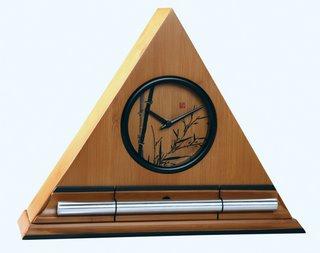 Bamboo Zen Alarm Clock with Chime Now & Zen’s Singing Bowl Alarm Clock Shop
1638 Pearl Street
Boulder, CO 80302
(800) 779-6383
Posted in Hot Springs, Now & Zen Alarm Clocks, Well-being
 Katsushika Hokusai Ukiyo-e, Japanese Iris There’s a good reason that people say you should “sleep on it” when facing a tough problem—it helps! A new study suggests dreaming is beneficial for problem solving. Psychology Today reports, “In REM sleep, cortical activation spreads from whatever one’s been pondering to marshal associated ideas, thanks to changes in levels of the neurotransmitters norepinephrine and acetylcholine.” Jasper Johns, Jack Nicklaus and many others have credited their dreams for successful ideas. A co-author of the study adds: “So many times, we already have the solution somewhere in our brain. It just needs an extra ‘boost’ before it can be accessed.”
adapted from Psychology Today by Elizabeth Ryan, October 2009
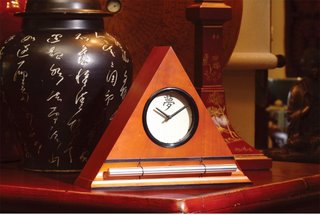 Zen Alarm Clock Now & Zen’s Alarm Clock Headquarter Store
1638 Pearl Street
Boulder, CO 80302
(800) 779-6383
Posted in Bamboo Chime Clocks, Chime Alarm Clocks, Japanese Inspired Zen Clocks, Natural Awakening, Now & Zen Alarm Clocks, Sleep Habits, Ukiyo-e, Well-being
 sleep for well-being A good night’s rest can help you lose weight, beat depression, and ward off heart disease.
PEOPLE THINK sleep is a waste of time,” says James P. Krainson, M.D., director of the South Florida Sleep Diagnostic Center in Miami. “But they don’t realize that sleep will make them more productive.” It will also help you improve your memory, shed postpregnancy pounds, and stave off obesity, heart disease and diabetes. Dozens of studies support the notion that sleep is just as important for maintaining good health as diet and exercise. For example, a study published in the journal Sleep found a relationship between short sleep and increased diabetes risk. Other studies found a lack of sleep can exacerbate pain, cause mood disturbances, and even increase the risk of gum disease.
Your wake–up call
If results from a 2007 Sleep in America poll are anything to go by, too many women are risking their health from lack of sleep. Conducted by the National Sleep Foundation (NFS), last year’s poll revealed that 60 percent of American women get a good night’s sleep only a few nights per week or less. Apparently, when women are pressed for time–which, let’s face it, is every day—sleep is usually the first thing to go.
To help you get back in bed and waking up well rested we looked at two sleep ailments–and discovered some surprisingly effortless solutions.
THE PROBLEM: No time
Recent research at the University of Pennsylvania, published in 2007 in Sleep, says our work–driven culture keeps us from getting the rest we need. Among the findings: The more time we spend working and commuting, the less time we spend in bed. Even when we know that getting more sleep will make us feel better, it usually isn’t enough to keep us from burning the candle at both ends, says Michael Breus, Ph.D., sleep expert and author of Beauty Sleep: Look Younger, Lose Weight, and Feel Great Through Better Sleep (Plume, 2007). What’s required, Breus says, is a plan for making sleep a priority:
Set your clock for sleep
Set your Zen Alarm Clock with Chime to go off an hour before you want to go to sleep. The gentle Chime Alarm is your cue to start getting ready for bed.
Wind down for an hour Take 20 minutes to shut down the house for the night and prepare for the next morning. Spend the next 20 minutes doing your usual evening ablutions like washing your face, brushing your teeth, and changing into your pj’s. For the final 20 minutes, set your Meditation Timer with Chime for 20 minutes so that you can relax and meditate in bed. That’s it. No work, reading, e–mails, phone calls, paying bills, or getting into a discussion with your partner about your health, finances, or relationship during your power–down hour, says Breus. “Avoid any activity that gets your mind revved up before you go to bed,” he advises.
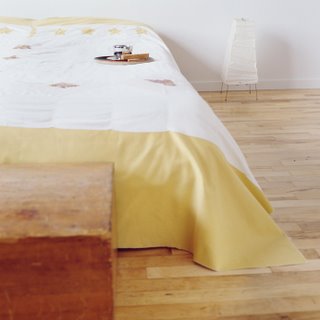 Create a Sleep Sanctuary Create a sleep sanctuary
“I’ve gone into bedrooms of people who say they can’t sleep, and they’ve got a computer in there, a TV, a huge pile of laundry on the floor,” says Breus. The question then becomes, according to Breus, not “Why can’t I sleep?” but “How could I sleep under these circumstances?” To transform your bedroom, Breus recommends moving the computer and the TV out of the room and clearing out the clutter. “You want to create an area that’s flowing and positiv; he writes in his book Beauty Sleep.
THE PROBLEM: Insomnia
Insomnia—from the Latin word for “sleepless” –is the most common sleep disorder, characterized by difficulty falling asleep, waking up in the middle of the night and not being able to fall back asleep, or waking up too early in the morning. For a clinical diagnosis, the lack of sleep must impair your daytime functioning, says Gregg D. Jacobs, Ph.D., sleep specialist at UMass Memorial Medical Center and founder of cbtforinsomnia.com. “Almost half of all adults have insomnia once a week,” he adds. But only a fraction of sufferers seek treatment, in large part, Jacobs says, “because they’re afraid their doctor will prescribe sleeping pills, and there is a growing belief that pills are not a good choice.” Try these drug–free solutions instead:
Retrain your brain for sleep
Cognitive behavior therapy (CBT) is a common psychological technique used to help people change the way they think and act and thereby break certain self–destructive habits. In two major studies in the Journal of the American Medical Association and one study in the Archives of Internal Medicine, cognitive behavior therapy proved to be more effective than sleeping pills, says Jacobs. “And unlike pills, CBT has no side effects and works long term.”
The CBT insomnia treatment program that Jacobs developed and tested at Harvard Medical School and UMass Medical Center (now online at cbtforinsomnia.com) involves five sessions over five weeks. It teaches insomniacs many techniques—like waking up at the same time every morning, including weekends; and when sleep doesn’t come within 30 minutes, getting up and doing something quiet and relaxing–that help people reform their sleep habits.
RESOURCES Check with the National Association of Cognitive– Behavioral Therapists Organization, nacbt.org, to find a practitioner.
Try melatonin
The same hormone that your body produces to induce drowsiness, melatonin, can be purchased overthe– counter in a pill form. Unlike valerian, “melatonin usually has an immediate effect,” says Wong.
BUYING GUIDE Look for Puritan’s Pride melatonin at puritan.com. DOSAGE Take 0.3 mg per day about 30 minutes to an hour before bedtime. “The recommendation on product bottles, 1 to 3 mg, is higher than many practitioners believe it should be,” says Wong. “There’s concern that too large a dosage could cause the body to reduce its own production of melatonin.”
 calming lavendar, aromatherapy for sleep Sniff lavender before bed
When 31 “healthy sleepers” aged 18 to 30 years in a Wesleyan University peer–reviewed study (published in 2005 in the journal Chronobiology International) sniffed lavender essential oil over the course of one half hour before bed, it increased the amount of time they spent in the most productive stages of sleep, and they reported feeling more rested the next day.
BUYING GUIDE Try Aura Cacia lavender oil at health food stores or natural markets or at auracacia.com.
DIRECTIONS “Put a few drops of lavender oil in a warm bath about an hour before bed,” suggests Wong. “A warm bath raises body temperature. When it falls after you get out, that drop causes you to feel drowsy.”
Boulder, Colorado—an innovative company has taken one of life’s most unpleasant experiences (being startled awake by your alarm clock early Monday morning), and transformed it into something to actually look forward to. “The Zen Alarm Clock,” uses soothing acoustic chimes that awaken users gently and gradually, making waking up a real pleasure.
 Gentle Chime Alarm Clock for a Progressive Awakening Rather than an artificial recorded sound played through a speaker, the Zen Clock features an alloy chime bar similar to a wind chime. When the clock’s alarm is triggered, its chime produces a long-resonating, beautiful acoustic tone reminiscent of a temple gong. Then, as the ring tone gradually fades away, the clock remains silent until it automatically strikes again three minutes later. The frequency of the chime strikes gradually increase over ten-minutes, eventually striking every five seconds, so they are guaranteed to wake up even the heaviest sleeper. This gentle, ten-minute “progressive awakening” leaves users feeling less groggy, and even helps with dream recall.
adapted from Natural Health Magazine
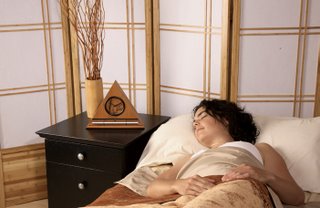 Wake up to the Zen Alarm Clock with Soothing Chime for a Progressive Awakening
Now & Zen’s Natural Chime Alarm Clock Shop
1638 Pearl Street
Boulder, CO 80302
(800) 779-6383
Posted in sleep, Sleep Habits, Well-being
 sleeping in can change your life Changing Your Life: Getting More Sleep Can Improve Your Health
By LARA SALAHI (@larasalahi1) and CHRISTINE BROZYNA
Researchers say lack of sleep is connected to cardiovascular disease, hypertension and high blood pressure. It also compromises the immune system, contributes to obesity and severely impairs mental judgment.Dieting might be more difficult too. Recent findings also show that when you are sleep deprived, your body actually boosts production of the hormone that makes you hungry.
But research suggests that getting just one extra hour of sleep each night could dramatically affect your health. In fact, researchers from the University of Chicago found that those who bumped up their hours of sleep, from 6 to 7 hours had a 33 percent decreased chance of having clogged arteries.
Just the anticipation of an alarm clock jolting you awake can contribute to poor sleep habits and the lose of sleep. Using a soothing, chime alarm clock will help you avoid this anxiety. The maker’s of the Zen Alarm Clock have mastered this with the production of their entire line of soothing, Chime and Gong Alarm Clocks with real acoustic sounds.
 Soothing chime and gong alarm clocks by Now & Zen, Inc. Now & Zen, Inc.
1638 Pearl Street
Boulder, CO 80302
(800) 779-6383
Posted in Bamboo Chime Clocks, Now & Zen Alarm Clocks, Well-being
 satisfy your spirit by creating a sleep oasis Create your sleep oasis with a mind/spirit component to satisfy your spirit. Discourage thoughts from continuing to churn at night by eliminating any sources of distraction, keeping work and stimulating entertainment (like TV and laptops) out of the bedroom. Rather than a thriller novel, grace the bedside with divinity: A small statue of the Buddha, Ganesha, Jesus, a revered saint, or other sacred figure can serve as a grounding, comforting presence, especially when paired with a natural element — a smooth stone, an acorn, a bowl of white sand. Alternatively, consider creating a bedside altar that honors the people you love, complete with small framed photographs and personal artifacts that reflect their spirit. With body, mind, and spirit thus cradled and protected, you can enter into sleep peaceful and complete.
Falling asleep is a natural progression into your body’s unconscious state. Using a Now & Zen alarm clock will progressively wake you up, mimicking your body’s natural waking process. Now & Zen alarm clocks come in a variety of styles to best compliment your sleep oasis.
Now & Zen Alarm Clocks adapted from Body + Soul Magazine, February 2006
 Alarm Clocks to Create a Sleep Oasis in Your Bedroom Now & Zen’s Clock Store
1638 Pearl Street
Boulder, CO 80302
(800) 779-6383
Posted in Natural Awakening, sleep, Sleep Habits, Well-being
« Previous Page — « Previous Entries
Next Entries » — Next Page »
|
|
|
|